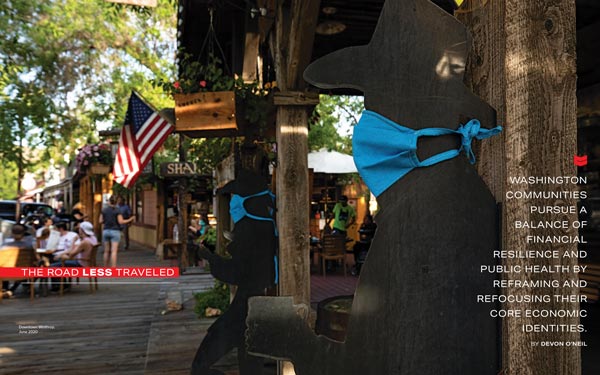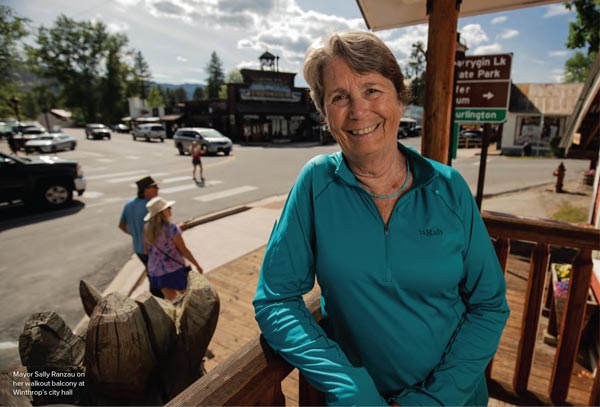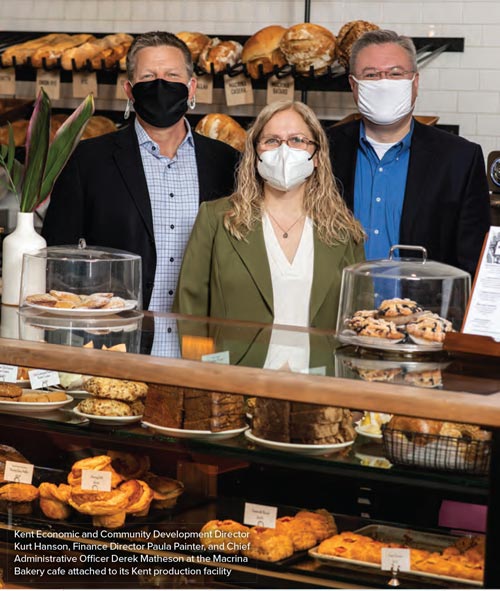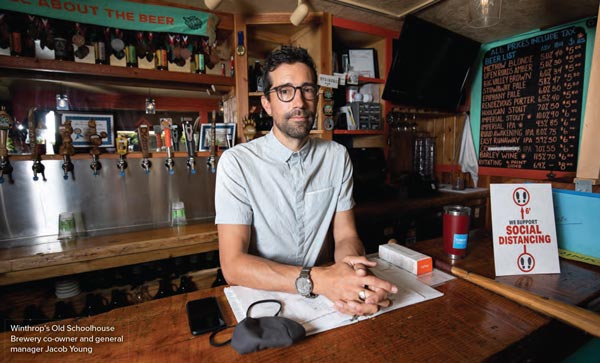Hear a read-aloud version of this article on the CityVoice podcast, Season 3, Episode
4.
Washington communities pursue a balance of financial resilience and public health by reframing and refocusing their core economic identities.

Sally Ranzau, the mayor of Winthrop, has spent her entire life in mountain towns.
She grew up in Estes Park, Colorado—the gateway to Rocky Mountain National Park–and lived there for 40 years before relocating in 1996 to this Old West–themed town of 488 in the stunning Methow Valley. She’s owned sport shops,
run a cabin-rental business, served as a ski patroller, even worked for the National Park Service. She knows exactly how much places like Winthrop depend on tourists who spend money–which is why the idea of doing what she did in early March
felt like swimming up a Class V rapid.
Soon after the Covid-19 pandemic exploded in Washington, area locals began fearing an infusion of outsiders who might endanger their isolated community, where the nearest hospital is an hour’s drive away and the nearest ICU is twice that distance.
Someone started a Change.org petition to “Close the Methow” and use municipal marketing dollars to discourage visitors—and second homeowners—from coming. Ranzau, a 70-year-old retiree who was elected Winthrop’s mayor
in 2017, received multiple emails a day urging her to act in the name of public safety. She resisted an outright closure of the North Cascades Highway, the main summer driving route for folks coming to the Methow Valley from the Puget Sound region,
but Ranzau did ask her town’s marketing director to stop advertising Winthrop as a destination—a move that ran counter to what Winthrop had done for nearly 50 years.

The marketing director, Anne Young, talked Ranzau out of turning off the promotional faucet entirely, but they agreed to change their message. For the next two months, their radio and television ads in Seattle and Spokane courted visitors with a caveat,
asking people to think of Winthrop only after “it’s safe to adventure again.” In other words, as the local paper paraphrased in a headline: “Don’t just stay at home—stay away!”
The unprecedented move made sound public-safety sense, but it imperiled the town’s financial health. More broadly, it represented the excruciating choices and extreme measures that municipalities throughout Washington, and around the world, have
taken to protect their citizens from the pandemic—while hopefully not crippling their economies beyond repair.
“It’s been very stressful,” says Ranzau, an avid outdoorswoman who introduced fatbiking to the valley more than a decade ago after a shoulder injury sidelined her from skiing. “There have been a lot of times when I wished I wasn’t
mayor, but all in all, I’m trying to keep my attitude positive, and I’m not panicking. When there’s an event like this that you really can’t do anything about, you have to just flow with what’s happening.”
Winthrop wasn’t always a tourist town. Until the North Cascades Highway (SR 20) opened in 1972, it had been a remote, dead-end destination (reachable by paved roads only from the south) offering no real reason to visit. To take advantage of the
new throughway, locals rebranded the town as a Western-themed tourist attraction, and suddenly Seattleites flocked. There are still no stoplights, fast food joints, or chain stores, a feature that enhances Winthrop’s allure in the Methow, a
long glacial valley with world-class Nordic skiing and summer trails that also serves as a gateway to North Cascades National Park.
The town’s government includes about a dozen employees who regulate and support a summer economy that, prior to the pandemic, was built on a foundation of festivals, sporting events, and small-town cultural attractions like a bustling Main Street
with numerous shops and restaurants along wood-plank sidewalks. At its height in summer, which is when the economy goes from a purr to a sizzle, the town’s population can swell tenfold to 5,000 people. May is typically the kickoff, with events
every weekend and natural attractions like trails and campgrounds drawing the first warm-weather visitors.
This year, however, events dropped from the calendar like falling dominoes. Corporate retreats canceled. So did mountain bike camps and valley mainstays like the 75th annual 49er Days and the Sunflower Relay and Iron Event, a four-decade-old trail run
that draws thousands of racers and spectators. Still, even as the pandemic raged, trails remained open, as did essential businesses like restaurants (for takeout service) and bike shops.
So when SR 20 opened just before Memorial Day, cooped-up urbanites flocked for a taste of mountain air and culture, defying public-health recommendations that they stay home. While many of Winthrop’s 125 or so businesses had to remain closed due
to local and state mandates, causing some to teeter on dissolution, plenty of others welcomed tourists and their dollars like famished bears in spring. Hotel tax revenues were down, but the town’s retail/use tax revenue through May 31 was still
its highest ever, some $10,000 over last year’s record pace. It seemed the “don’t come now” messaging enticed, rather than curtailed, visitation and bolstered local coffers—for better or worse.
While Winthrop gets by on a $5 million budget, the financial impact of the pandemic, in hard dollar numbers, was substantially larger for many Washington cities. One of those cities is Kent, the state’s sixth-largest municipality, tucked between
Seattle and Tacoma in the economic colossus of King County. Since 1990, Kent’s population has quadrupled to around 130,000, while its economy revolved around aerospace, manufacturing, and warehousing (including an Amazon fulfillment center).
A dozen years ago, when the state Legislature changed the way sales tax was collected—from point of origin (which had benefited warehousing cities like Kent) to a product’s point of destination (which benefited interstate e-commerce)—the
shift cost the city $12.7 million a year in lost revenue. It was a severe blow to Kent, which costs $346 million to run in a given year, roughly a third of which comes from its general fund. Since then, city planners have been trying to diversify
Kent’s economy, breaking up massive warehousing districts into more human-scale mixed manufacturing/warehousing/retail zones with pedestrian-friendly amenities.
One innovative program, dubbed “make it in back, sell it in front,” encouraged wholesalers and manufacturers to open commercial storefronts. The program’s success became clear in 2016, when Macrina Bakery moved its production kitchen
to Kent, having outgrown its facility in Seattle’s SoDo neighborhood: the beloved Emerald City cafe opened a street-facing breakfast and lunch outlet that’s become an oasis for local warehouse workers craving a Nutella brioche or demi
baguette sandwiches. More recently, the city’s Rally the Valley program has attracted a mix of revenue-generating retail operations, such as dog day care facilities and automotive repair shops, to an industrial manufacturing zone where they
had previously been excluded by regional land-use regulations.

Coupled with its concerted efforts to diversify, the city adopted a policy—born of its experiences in the Great Recession, when its cash reserves dropped to a fraction of 1 percent—requiring at least 18 percent of annual expenditures to be
held in reserve at the end of each year. Going into March, Kent was on pace to far exceed that, projecting 28 percent in reserves by the end of 2020. At the same time, however, Kent’s expenditures were outpacing revenue by about a million dollars
per month—despite all of the city’s efforts, a deficit eerily equivalent to the amount it lost with the 2008 sales tax shift.
Then the pandemic hit. Early economic impacts and predicted losses through December exposed a looming $15.7 million gap, which would have to be made up either through spending cuts or by buying it down with reserves. The city’s leadership team quickly
realized they would have to use both tools—and fast. “It’s hard to turn a ship this big,” says Derek Matheson, Kent’s chief administrative officer. “It takes time, and we knew we had to act quickly. We did it in
a little over a month.”
Matheson and his staff, led by Finance Director Paula Painter, drew from a number of funds and considered everything from mass salary reductions to furloughs to voluntary retirement. Departments prioritized people and projects and came up with a list
of potential cuts in 5 percent increments, starting at 5 and going all the way to 20, in case the pandemic’s impact worsened. Because the year was already three months old, the cuts were significantly more drastic than the percentages represented.
“The city went through several rounds of layoffs during the Great Recession, so we wanted to tackle this exercise one time,” says Painter, who’s worked for Kent for 18 years. “That’s why we went to 20 percent with our
fund cuts.”
The city tried to minimize personnel reductions, but it still froze or eliminated 27 positions, furloughed 23 employees, and chose not to hire 300 part-time summer positions in the recreation department, where programming had been severely curtailed by
public health orders. Those furloughed ranged from a recreation program assistant all the way up to the recreation superintendent. “Most of them were reduced to half time, and through the state’s shared work program they were eligible
to apply for unemployment for the other half,” Matheson says.
Because of Kent’s ample reserves (“We created the fund balance for a rainy day, and it’s pouring,” city leaders have repeated endlessly, like a mantra), department heads have not yet been forced to act on anticipated 20 percent
cuts, but even halving that was gut-wrenching. “We were all in the 10 percent ballpark,” Matheson says.
“It was incredibly painful with every department,” Painter adds. “I had so many conversations with my colleagues, and my heart broke for them because I knew how hard it was—as I had to make them in my department, too.”
In Winthrop, decisions were made at a more micro level, and often in the private sector. While hotels and retail shops remained shuttered under public health restrictions, “essential” businesses that were allowed to remain open scrambled to
maximize revenue while keeping their employees and customers safe.
At Methow Cycle & Sport, the staff broke into two teams and attempted not to overlap for months, “so in the event that somebody did become sick with Covid-19, we could isolate that team and continue operations,” explains co-owner Julie
Muyllaert. As it did across the bike industry nationwide, revenue boomed as people sought new ways to get outside during the lockdown. “We saw people pulling bikes out of barns and sheds and garages that hadn’t seen the light of day in
years,” Muyllaert says. Sales of entry- and midlevel bikes spiked; repairs were backed up for weeks; and revenues were up 20 percent year-to-date, even after a record year in 2019.
But Muyllaert also serves as vice president of Winthrop’s chamber of commerce, where she worked to help other businesses not as lucky as hers. “One of the gaps was the PPP [federal Paycheck Protection Program] wasn’t working for a lot
of our very small businesses, because they were sole proprietors and didn’t have much payroll,” she says. To fill the void, in the neighboring community of Twisp, 25 grants of $1,500 were awarded through the TwispWorks–facilitated
Methow Valley Small Business Emergency Grant Program. Old Schoolhouse Brewery, one of Winthrop’s most popular social hubs, used one of the grants to start canning its beer—a move that had been in the company’s five-year plan but
was expedited out of necessity.

“I didn’t expect the grant to come through since we’re one of the larger businesses in the valley,” says co-owner and general manager Jacob Young, 40, who moved to Winthrop four years earlier from Santa Fe. “But we spent
it right away—we got two pallets of cans the same day.”
Old Schoolhouse makes most of its money in the summer and uses that windfall to remain open through the winter, when many local businesses close. The brewery secured a PPP loan to keep its staff employed at the initial height of the crisis, when sales
were between 20 and 30 percent of normal. They’ve since climbed to about 50 percent, but the pandemic “is hitting us harder and harder as we get into summer,” Young says. “We’re not even at half of what we’d normally
be on the year.” Nevertheless, Young and his partners put down a deposit on their own canning system June 23, taking on debt to secure a brighter future post-pandemic.
More broadly, Winthrop’s chamber was preparing workshops for businesses to manage their cash flow in advance of what could be a very slow winter. But uncertainty persists. The Methow Valley (where there had only been five Covid-19 cases as of late
June, according to Ranzau) has been scorched by wildfires four of the past six summers. You don’t have to own a business to see why another fire—and its clouds of smoke, which make recreation and tourism significantly less appealing—could
be devastating to a small town on the brink.
“Many of our businesses will be able to weather Covid-19, I believe, if we don’t have a bad fire and smoke year,” Muyllaert says. “Everything will change for the worse if we do.”
Meanwhile, Kent’s leaders are relying on national brands and industries to stay relevant and afloat, while economic development staff take a nimble, tailored approach. Alongside contracting with Green River College’s Small Business Center
to assist local businesses, department staff are providing individualized advice to some of the city’s 4,000 business owners and listening to investors and developers when they panic about financing. Lately, the goal has been to stimulate re-employment
of laid-off workers and make the most of $1.2 million in small-business grants that came from the federal CARES Act.
“We’re estimating we’ll get 1,500 applicants for the grants,” says Bill Ellis, Kent’s chief economic development analyst. “But at the end of the day, we’ll probably only award 200: either we can spread peanut
butter thin or make bigger impacts by increasing our award size to $4,500.”
Additionally, to mitigate widespread layoffs in its aerospace and aviation industries, Kent is using grant money to train the city’s most vulnerable residents on how to work in a Covid-19 environment, then reimbursing employers up to $2,250 if they
hire one of those workers, or for the training time. “No one’s really focused on reducing unemployment; that’s mainly a recovery phase tactic,” says Ellis. “So I think that’s a cool pivot for us.”
And then there’s the new space race. If you didn’t know that Boeing built lunar rovers and rocket thrusters for NASA during the Apollo program in Kent, or that much of the research and development work for the International Space Station happened
in Kent, you’re not alone. “We’re like the Silicon Valley of space, and nobody talks about us because the rocket launches are visible elsewhere when the most critical intellectual property is developed here,” says Ellis, noting
that Kent’s Shape Technologies Group also happens to be a SpaceX supplier. That is likely to change now that Blue Origin, the private “new space” company headed by Amazon founder Jeff Bezos, has been awarded a contract (as of April
this year) to put the first woman on the moon via the multination Artemis program. Price tag in US government funding: $500 million.
Blue Origin has been adding staff for years and is on its way to 3,000 workers, who build rocket ships and capsules and thrusters using metals supplied by other Kent manufacturers. As Kurt Hanson, Kent’s director of economic and community development,
puts it, referring to one of the giants of 20th-century economic theory: “Keynes himself couldn’t have planned a better countercyclical investment into our local aerospace manufacturing hub in the midst of this recession.”
Back in Winthrop, things could be worse. At the end of June, the town had $276,000 in reserves—if needed, enough to coast with no revenue for four months. As for Mayor Ranzau? Sure, she was concerned for her adopted hometown, trying to stave off
worst-case scenarios and squeeze every bit of busy-ness out of what normally would be the busiest season. “I fear that come fall, if the summer is not good for some people, we might have a lot of businesses close,” she said. “I’m
less worried about the volume of tourists than whether they’re the type who are actually spending money.”
The worry had been nonstop since mid-March, and the stress wasn’t going away. So Ranzau was preparing to hike out of town for a much-needed break: three nights backpacking in the Lake Chelan–Sawtooth Wilderness.
No cell service? “Exactly,” she said.
“I know where my level of stress is,” she added. “I really need to be out in the high vistas with the flowers and birds, and not see any people. Then I’ll be reset and ready for whatever happens next.”
The same can’t be said for tourists from Seattle, who continue to travel to the Methow Valley to engage in the kinds of outdoor activities approved by the state for Okanogan County (and King County, for that matter). Near the entrance to town, they
are greeted by a sign that reads: “Howdy Partner, Keep Winthrop Safe, Wear a Mask.”
That’s a suggestion many visitors choose to ignore, just as readily as they leap at the opportunity to resume their favorite outdoor pastimes. “People will call and ask if we’re open and if it’s safe,” says Muyllaert of Methow
Cycle & Sport. “We’re providing information, then we’re allowing them to make their own decision on whether to come. We can’t be in the position of policing people’s decisions. But we’re ready to assist them
if they walk through our doors.”
At Old Schoolhouse, Jacob Young has a manifesto for guests. “The first rule is: be nice,” he says. And in a poignant echo of Winthrop’s interim destination marketing message, he adds, “We have shifted a bit from ‘the customer
is always right.’ We have rules here, and if you’re not ready to abide by them, then maybe just wait a bit and come back later.”